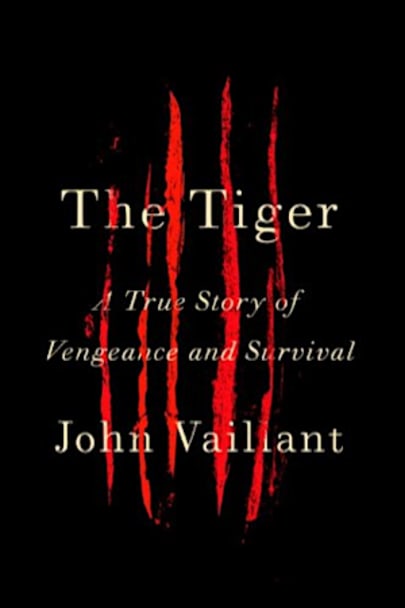It’s December 1997, and a man-eating tiger is on the prowl outside a remote village in Russia’s Far East. The tiger isn’t just killing people, it’s annihilating them, and a team of men and their dogs must hunt it on foot through the forest in the brutal cold. As the trackers sift through the gruesome remains of the victims, they discover that these attacks aren’t random: the tiger is apparently … apparently engaged in a vendetta. Injured, starving, and extremely dangerous, the tiger must be found before it strikes again.
As he re-creates these extraordinary events, John Vaillant gives us an unforgettable portrait of this spectacularly beautiful and mysterious region. We meet the native tribes who for centuries have worshipped and lived alongside tigers, even sharing their kills with them. We witness the arrival of Russian settlers in the nineteenth and early twentieth centuries, soldiers and hunters who greatly diminished the tiger populations. And we come to know their descendants, who, crushed by poverty, have turned to poaching and further upset the natural balance of the region.
This ancient, tenuous relationship between man and predator is at the very heart of this remarkable book. Throughout we encounter surprising theories of how humans and tigers may have evolved to coexist, how we may have developed as scavengers rather than hunters, and how early Homo sapiens may have fit seamlessly into the tiger’s ecosystem. Above all, we come to understand the endangered Siberian tiger, a highly intelligent super-predator that can grow to ten feet long, weigh more than six hundred pounds, and range daily over vast territories of forest and mountain.
Beautifully written and deeply informative, The Tiger circles around three main characters: Vladimir Markov, a poacher killed by the tiger; Yuri Trush, the lead tracker; and the tiger himself. It is an absolutely gripping tale of man and nature that leads inexorably to a final showdown in a clearing deep in the taiga.
From the Hardcover edition.
more



Not the typical book for me, but it was based on a true story of a Siberian tiger going haywire in the late 90s, attacking Russian villagers in an unusual way. I loved the movie Ghost and the Darkness, about another similar tiger true story, so decided to give it a try. Here’s the thing, the parts about the actual Russian tiger attack and subsequent hunt were super, kept the pages turning. Gave it a 4-Star because the author often went off on blah-blah-blah tangents, unloading research info that bored me. So I’d skip past those parts and pick up when the true story did. So, if you don’t mind skipping boring parts, I’d recommend it.
Imagine the tiger on Jungle Book as created BY Stephen King, with characters out of Jaws in one of the remotest regions of Earth with the game warden equivalent of the Martin Cruz policeman. Yet it is non-fiction…
This is a book not only about Amur tigers but also about the region and the people. I spent some time in the region before and after the fall of the Soviet Union and it was interesting to have someone explain how difficult life is there for the people. I hunted in the 1980s with a Soviet colonel that killed a tiger that had become a problem. I have a photo of the cat in my guest house that mostly hunters stay. It’s not PC enough for the main house.
Despite what some reviewers have said, I consider the whole narrative informative and not boring at all. Perhaps that is just me because I saw it before and after the fall of the USSR. When you understand the difficulty of life there you understand a little more why there is so much what we call poaching going on. Of course this leads to the wounding of tigers which turns them into problem tigers.
Read this book with an open mind and certainly do not skip over parts about the people.
An odd mix but worth the read/
I loved this book! The combination of the character development along with the research and history of the tiger was amazing!
I LOVED this book, but I am a naturalist nature writer and passionate about the connection between man and his environment and those animals that share this planet with us. Seems there are more tigers in captivity (2,000) in the USA than in all of Russia and Asia.
The Russian history information was eye-opening.
Recommend highly.
To the descriptive terms offered, I would add Suspenseful. The book described a way of life in eastern Russia that I knew little about and an understanding of the tiger. But what made it a page-turner was the interplay between the hunters and the tiger.
Captivating writing, couldn’t put it down.
The author does a masterful job of weaving the story of the tiger hunt with relevant historical background and the backstories of the characters. I would have given it five stars if it had not veered into social justice, but that might be what some readers like.
Informative written in a very easy to read way. Enjoyable
Besides telling of the tiger attack and the hunt for that tiger, this book gives you an insight into an area of Russia that might be unfamiliar to many.
Gave me a good insight into the massive tigers living in Russia and China. A lot of places were truly page-turners, but almost TMI.
For those concerned about the civilizational crisis of climate change that confronts us as we emerge from the coronavirus pandemic, The Tiger presents an holistic–as opposed to utilitarian–approach to conservation of the more-than-human world: don’t just preserve individual threatened species, preserve the entire ecosystem in which they occur. As carbon-induced warming accellerates the ongoing extinction of species upon which human survival will ultimately depend, this book’s compelling narrative will increasingly appear as prophetic.